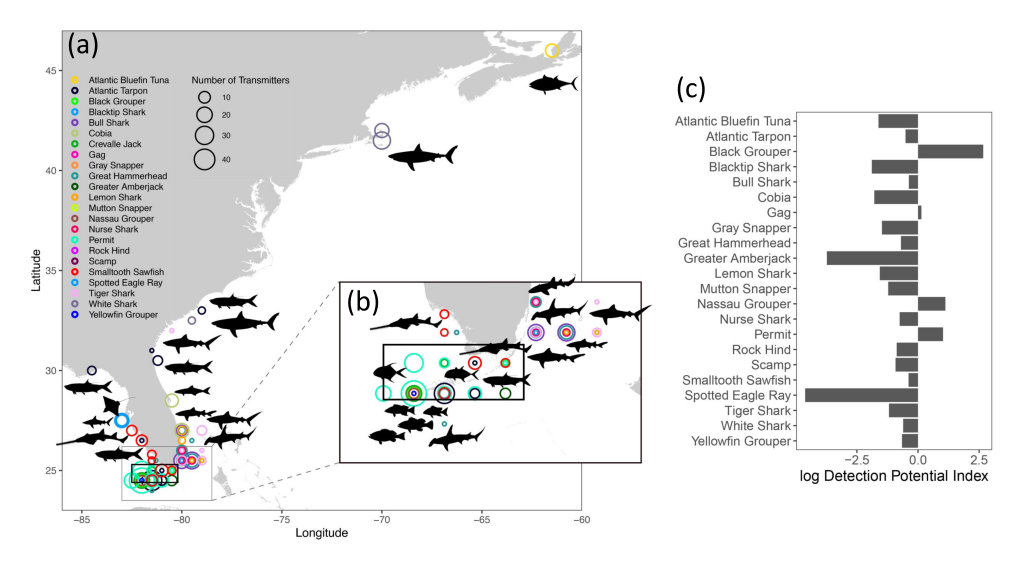For years, researchers have used tracking devices to monitor fish movements and growth in this area of study is exponential, researchers say. But this growing data base has not yet been effectively integrated into conservation decisions, understanding ecosystems or monitoring fish health, among other purposes. That’s a missed opportunity a recent study published in Trends in Ecology and Evolution says.
Scientists across the globe analyzed more than 1,800 research papers and found that while the data gathered is impactful, researchers must do more to make better use of the information.
With acoustic telemetry, scientists tag fish with tracking devices that emit signals. Researchers record and save the signals to follow fish movements over time. From inland lakes and rivers to the high seas, and from polar regions to the tropics, scientists use this technology to provide insight on ecological factors including migration patterns, spawning and mating behaviors and any passage impediments.
“Tracking data is exploding,” said Susan Lowerre-Barbieri, a scientist with the UF/IFAS and Florida Fish and Wildlife Research Institute. “This paper looks at how acoustic telemetry has grown and its potential applications to management. We found there is a huge gap there. We have an opportunity to understand fish movement and behavior in a way we never have before.”
“Movement ecology is a burgeoning field in science, and we were interested in knowing how well research objectives meet the management needs of aquatic animals,” said Jordan Matley, assistant professor at St. Francis Xavier University in Chicago and lead author of the paper. “Ultimately, we wanted to identify where this type of research should be directed to facilitate greater understanding of the aquatic realm, globally.”
The project included researchers across the world to provide a global perspective and to highlight regional trends where more research may be needed. Prior to this study, no scholars had done a global review of acoustic tracking of fish.
“Typically, most papers focus on fresh or saltwater studies,” Lowerre-Barbieri said. “They are not looking at a bird’s-eye view to pull together freshwater and marine-level information and looking at different impacts to ensure these populations stay healthy.”
A deeper understanding of the data can help prevent further ecosystem and population crises. Better utilizing these data can improve our understanding of fish productivity and how to manage these populations for future success.
One example is a recent study in the Florida Keys, a highly connected ecosystem and home to the world’s third largest barrier reef. Before the study, researchers had limited data on the region, despite the fact that it’s a superhighway for migratory and resident species. Researchers analyzed four years of acoustic telemetry data, which included 2 million detections that followed the movements of 23 different species.
 “There were two findings that were quite surprising,” said Lowerre-Barbieri. “One was the relatively large number of great white sharks detected in the study. Before we began monitoring the seamounts, this behavior was unknown. The other big surprise had to do greater amberjack at the seamounts.”
“There were two findings that were quite surprising,” said Lowerre-Barbieri. “One was the relatively large number of great white sharks detected in the study. Before we began monitoring the seamounts, this behavior was unknown. The other big surprise had to do greater amberjack at the seamounts.”
The Keys are known to be an important spawning site for many fish species. These locations are also hot spots for fishing and predators, which can lead to increased mortality due to predators feeding on hooked or released fish.
The seamounts are known greater amberjack spawning aggregation sites, which are heavily fished, but interactions with sharks remain undocumented.
“The level of shark depredation we observed when tagging was completely unexpected,” said Lowerre-Barbieri. “We lost as many fish to sharks as we landed.”
The data collected in The Keys is being used to support a recent seasonal fishing closure implemented in the Western Dry Rocks, a popular fishing area southwest of Key West that was included in the recent tracking study.
“Most fisheries management is still driven by single-species maximum sustainable yield, using data on abundance, biology and catch rates to set harvest control rules,” said Lowerre-Barbieri. “My colleagues and co-authors Dani Morley and Alejandro Acostas led the telemetry research at Western Dry Rocks and are leading assessment of its efficacy. Studies like this one can help provide multi-species and larger spatial scale data to better understand dynamics within a smaller closed area, like the Western Dry Rocks, including apex predator movements and areas they are drawn from.”
As concerns related to habitat loss and diminished biodiversity grow, data that show how species move and interact can play an important role in making management decisions to preserve the animals and the environments in which they travel. Tracking networks can connect dots to see how far fish have moved or look at different movements and movement strategies. Once scientists find a location with many data points, they can hone in on the area to understand ecosystem impacts.
“There is a need to integrate technological advances, testing these techniques and receiving funding to make them operational,” she said. “Although traditionally tracking data has not been integrated into management decisions, we are changing that by demonstrating how far this field has come and bringing together tracking scientists and those involved in management decisions through collaborative science networks.”
Lowerre-Barbieri’s lab leads iTAG, the Integrated Tracking of Aquatic Animals in the Gulf of Mexico. iTAG’s steering committee includes federal and state leaders in fisheries management.
“Having these leaders involved is huge because they know better than anyone the data gaps they need filled,” she said. “In these times of rapid technological change and habitat degradation it is critical that we adapt how we do research and communicate science to help ensure healthy oceans for generations to come.”
 1
1
